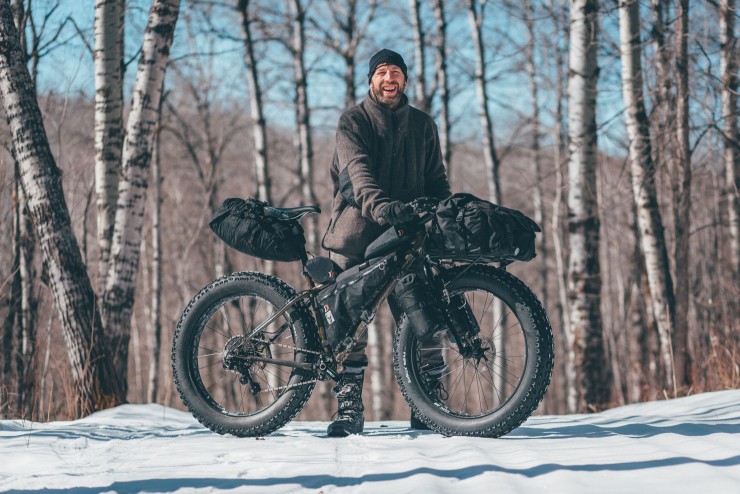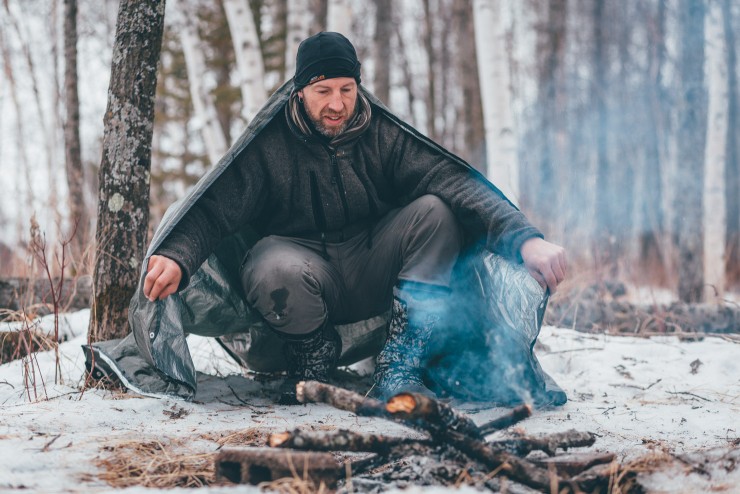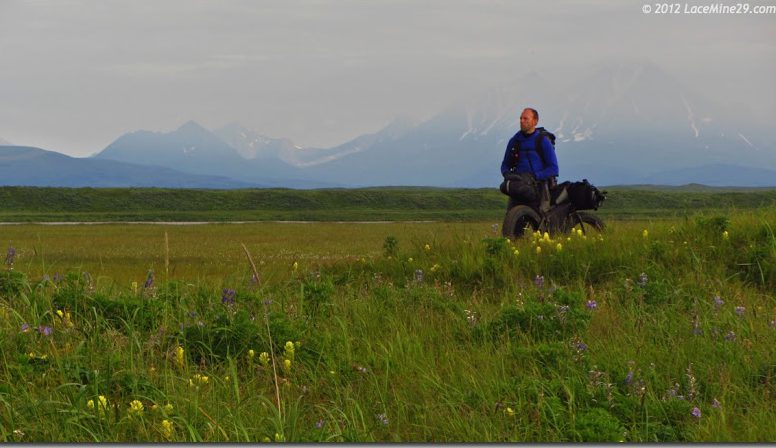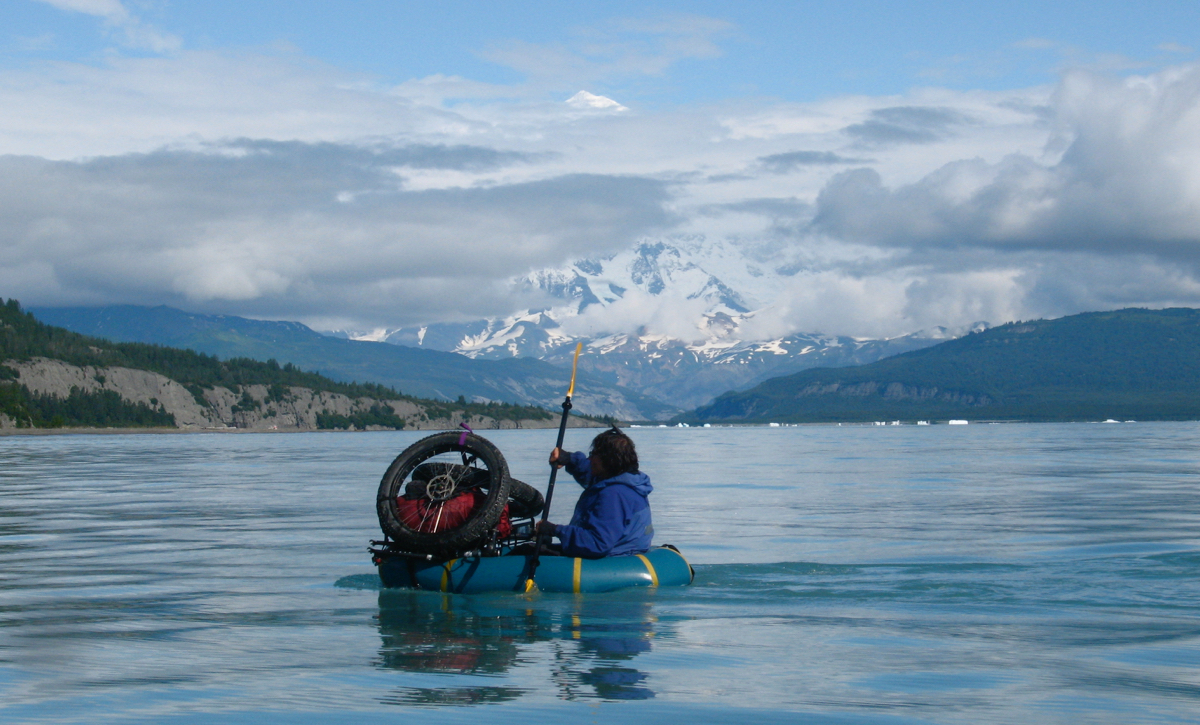Blog
stories • happenings • adventures
Dave Gray: A Q&A on The Parallel Development of Fatbikes & Bike Bags
Nearly two decades ago, Surly hired Dave Gray to design bicycle frames and components and to take the company to the next level. A long-time “bikepacker” (what he called “bike-camping” at the time) and the brainchild behind the Surly Pugsley, Gray has a unique insight into the history of bikpacking and the parallel development of fatbikes and bike bags. So, we gave him a call to ask him to reflect on the topic. Enjoy the Q&A.

Dave Gray doing some winter bikepacking in Duluth, Minn. Photo by Cass Gilbert.
Revelate Designs: Can you talk a little bit about your beginnings doing overnights with your bike?
Dave Gray: I started bike-camping about 18 years ago, usually rolling solo, riding road and cross bikes equipped with racks and panniers. Initially, I packed most of my gear over the rear wheel, because I underestimated how much rear-biased weight distribution negatively affected bike handling. When fully loaded with camping gear, my bike was often prone to speed-wobble and front-wheel washout in loose corners. Eventually, I incorporated a lowrider front rack and front panniers into the mix and greatly improved handling.
My campsites were typically within 35 miles from my home in Minneapolis. It didn’t take long to develop a preference for stealth sites located off the beaten path.
At first, I used whatever camping gear I had on-hand, including a second-hand, two-man Eureka tent, a cheap generic synthetic-fill sleeping bag, and a thin closed-cell foam sleeping pad. Most of my gear was heavy and bulky, but I made it work.
The discomfort and challenges experienced during those early overnight outings pushed me to hone my outdoor skills and refine my gear selection.
RD: You had a key role in Surly evolving from a single-speed, urban brand with a cult following into a brand that has become the go-to for dependable steel adventure bikes. How did this happen?
DG: Surly was comprised of tinkerers who commuted on bikes, camped with bikes, ran errands on bikes, and otherwise incorporated bikes into their lifestyles. And we knew that moving the cargo weight from our backpacks and messenger bags to our bikes added to the enjoyment of our rides, in many cases. So, we added heaps of braze-ons to our frames and forks, providing us (and our customers) with the means to mount a wide variety of gear-hauling components and accessories.
Our love for max tire clearance certainly lent itself to the adventure bike category. Bigger tires often provide more float and traction than skinnier rubber can over soft/loose/slippery terrain, while also delivering a more comfortable ride.
Due to its favorable ride characteristics, toughness, ease of repair (relative to other frame materials), and predictable failure modes, 4130 steel is an obvious choice for a frameset that needs to go the distance over varied terrain. Surly’s conservative tube butting profiles add to the dependability provided by the frame and fork material.

Photo by Cass Gilbert.
RD: You had a key role in developing the Pugsley, which was the first widely available fatbike. Its release coincided closely with the availability of frame bags and beginnings of modern bikepacking bags. How do you think this affected how the bikes were used and “understood” for lack of better words?
DG: The inclusion of framebags on fatbikes clearly showed the utility-leaning facets of these bikes. Until then, many people had a hard time imagining uses other than short recreational rides on snow or sand.
RD: How do you think the combination of purpose-built fat and adventure bikes like the Ogre and ECR with a dialed set of bags changed the way people viewed bike travel? Further, how do you think it affected the industry?
DG: By decreasing weight, narrowing the frontal profile, and offering more ways to distribute gear weight fore and aft, frame bags gave loaded bikes easier access to a wider range of road/trail/terrain conditions, meaning more remote campsites could be reached by bike. In addition, adventure bikes give all-weather/all-season/all-terrain bike commuters more bike options to choose from.
The adventure bike category gave rise to new bike companies, new bike lines from existing companies, and a plethora of new accessory options to support these bikes.
The non-bike sector of the outdoor industry has benefited, as well. Companies that offer light/ultralight/compact gear can serve the backpacking and bikepacking folks with the same products.
RD: What were your first Revelate bags, and what did you do with them?
DG: My first bag was a frame bag for my 1×1/Pugsley. Then I got a Monster Twinkie seat bag.
The frame bag is on the original Pugsley prototype, a bike that I still ride. In fact, it saw some trail action less than a week ago. The Monster Twinkie gets used when I need a seat bag that will swallow up my synthetic -20F sleeping bag and other low-weight/high-volume loads.
RD: You and Revelate founder Eric Parsons appear to have a few things in common from a design perspective. What are your thoughts on that?
DG: Form follows function? Designing for dependability, ease of repair, and long service life? Agreed.

RD: Your bike trips seem to combine unique combinations of bikes, bags with a Minnesota backwoods flavor. What’s your favorite part of it all?
DG: After my shelter is set up and my firewood is gathered for the evening, I enjoy sitting in front of a packable woodstove or small fire, drinking tea, and thinking about ways to improve on the food, gear, and packing systems in play. I always carry a small notebook to jot down my thoughts.
RD: As a designer, tinkerer and builder, what do you find most important on a backcountry bike trip?
DG: Simple, durable gear that is repairable in the field with minimal tools and supplies. And Gummi Bears.
RD: What’s your favorite piece of Revelate gear?
DG: That’s tough. I love my framebags, Gas Tanks, seatbags, Jerry Cans, and handlebar harness/bag systems. If I had to pick one item, I’d choose the Terrapin seat bag system. It sees the most miles on the widest array of bikes.

Dylan Kentch paddling across Icy Bay, Alaska, with Mount St. Elias in the background. Photo by Eric Parsons.
RD: Is there anything we aren’t asking you that you want to share with readers about bikepacking, your personal perspective on design, the industry, anything?
DG: Packrafts. Revelate bags were instrumental in adding packrafts to the mix. When a raft is being transported on a bike, the handlebar harness provides a secure lightweight way to haul rolled-up boats and four-piece paddles.
When a bike is being transported on the front of a raft, seatbags and handlebar bags are easy to stow. And items being carried in framebags while pedaling can typically remain there while the bike is strapped to the boat, so the transition time from pedaling to paddling and vice versa can be pretty short. Anyone who has experienced bikepacking days with multiple water crossings, requiring raft deployment, can appreciate this.
RD: Any final thoughts?
DG: Rarely do I ride a bike without at least one Revelate Designs bag affixed to it. Even when I’m riding a road-touring bike equipped with racks and panniers, I have a frame bag and a Gas Tank strapped on, as well. My longtail cargo bikes (Big Dummy and Big Fat Dummy) roll with frame bags and Gas Tanks, too. Tools, tubes, snacks, electronics, and extra clothing items ride in the Revelate bags, leaving more room in the cargo bags for, yes, you guessed correctly, cargo.
A bike without Revelate bags looks naked to me these days.
It has been a pleasure to get to know Eric. And I’ve truly enjoyed watching the evolution of the Revelate product lines. I’m looking forward to seeing whatever is next on the horizon.
